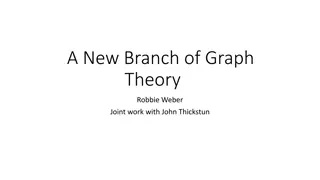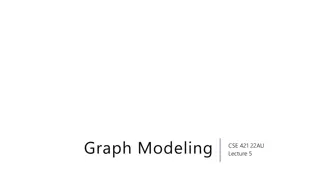Introduction to Graph Theory: Exploring Graphs and Their Properties
This content delves into the realm of graph theory, focusing on the fundamental concepts and applications of graphs. It covers topics such as the Seven Bridges of Königsberg problem, types of graphs, vertex degrees, degree sequences, handshaking theorem, and more. Through visual aids and explanations, it provides insights into the structure and characteristics of graphs, illustrating their significance in modeling real-world systems.
Download Presentation

Please find below an Image/Link to download the presentation.
The content on the website is provided AS IS for your information and personal use only. It may not be sold, licensed, or shared on other websites without obtaining consent from the author. Download presentation by click this link. If you encounter any issues during the download, it is possible that the publisher has removed the file from their server.
E N D
Presentation Transcript
CS 2210 Discrete Math Graphs Fall 2019 Sukumar Ghosh
Seven Bridges of K nigsberg Is it possible to walk along a route that crosses each bridge exactly once?
Seven Bridges of K nigsberg
What is a Graph A graphG = (V, E) consists of V, a nonempty set of vertices (or nodes) and E, a set of edges. Each edge connects a pair of nodes that are called its endpoints. Graphs are widely used to model various systems in the real world
Back to the Bridges of K nigsberg
Types of graph At most one edge between a pair of nodes Multiple edges between some pair of nodes
More examples of graphs Each node denotes an actor or an actress, and each edge between P and Q denotes that P, Q worked together in some movie. It is an undirected graph Hollywood graph Each node denotes a web page, and each edge from page P to Q Q denotes a link on page P pointing to page Q. It is a directed graph Web graph
Vertex degree The max degree of any node in a simple graph is |V|-1
Handshaking theorem Proof. Each edge contributes 2 to the sum on the RHS
A theorem THEOREM. An undirected graph has even number of vertices of odd degree. Proof. Should follow from the handshaking theorem Given a degree sequence such that the sum of the degrees is even, does there always exist a graph with that degree sequence? No, for simple graphs. Consider (3, 3, 3, 1). Can you draw a graph With the degree sequence (3, 3, 3, 1)? No (try this out) What is the maximum possible degree of a node in a simple graph? It is (n-1) if there are n vertices.
Types of graphs A cycle of a graph is a subset of its edge set that forms a path such that the first node of the path corresponds to the last. A connected graph with no cycle is a tree A set of one or more trees not necessarily connected No directed cycle in a DAG
Types of graphs The n-cube graph n=3 Complete graph or Clique: All vertices are adjacent to one another. A clique with n vertices is called a Kn Wheel graph
Types of graphs Bipartite graph A simple graph is called bipartite if its vertex set V can be partitioned into two disjoint subsets V1 and V2, such that every edge in the graph connects one vertex in V1 to another vertex in V2. V1 V2 Can always be colored using two colors.
Computer representation of graphs ADJACENCY MATRIX (taken from Wolfram Mathworld)
Computer representation of graphs ADJACENCY LIST Vertex Adjacent to 1 1 3, 4 2 2 3, 4 4 3 1, 2 3 4 1, 2 Can be represented as a linked list
Graph isomorphism Taken from MIT 6.042J/18.062J
Graph isomorphism Taken from MIT 6.042J/18.062J
Graph isomorphism Taken from MIT 6.042J/18.062J
Connectivity An undirected graph is connected if there is a path between every pair of distinct vertices of the graph. A connected component is the maximal connected subgraph of the given graph.
Connectivity issues Erd s number in academic collaboration graph Erd s number = n means the person collaborated with someone whose Erd s number is (n-1) Kevin Bacon number in Hollywood graph Actor Kevin Bacon once remarked that he worked with everybody in Hollywood, or someone who worked with them.
Cut vertex, cut set, cut edge A cut vertex (or articulation point ) is a vertex, by removing which one can partition the graph. A cut edge is an edge by removing which one can partition the graph. If multiple edges need to be remove to partition the graph, then the minimal set of such edges a cut set. Examples taken from Wikipedia
Connectivity in directed graphs A directed graph is stronglyconnected if there is a path from any vertex a to any other vertex b of the graph. A directed graph is weaklyconnected if there is a path between any two vertices of the underlying undirected graph. Strongly or weakly connected ?
Euler path vs. Hamiltonian path Hamiltonian path = A path that passes through every vertex exactly once. A closed path is a Hamiltonian circuit or cycle. Euler path = A path that includes every edge exactly once. A closed path is a Euler circuit or cycle. We have reviewed Euler path in the 7-bridges of Konigsberg Problem. It did not have an Euler path. Does it have a Hamiltonian path?
Hamiltonian path 1 2 4 5 3 Does the above graph have a Hamiltonian cycle? No! Hamiltonian circuit/cycle colored red
Shortest path In the above weighted graph, compute the shortest path from a to z
Shortest path: Dijkstras algorithm Read the algorithm from page 747-748 of your text book
Shortest path: Dijkstras algorithm Computes the shortest path from a source node to each target node L (source) = 0, and for all other node u, L(u) := infinity, S:= null while z is not in S u := a vertex not in S with L(u) minimal; S := S {u}; for all vertices v not in S if L(u) + w(u, v) < L(v) then L(v) := L(u) + w(u, v) {known as relaxation: this adds a vertex with minimal label to S and updates the labels of vertices not in S} return L(z)
Traveling Salesman Problem (TSP) A traveling salesman wants to visit each of n cities exactly once, and then return to the starting point. In which order should he visit the cities to travel the minimum total distance? TSP = Computing the minimum cost Hamiltonian circuit. TSP is an extremely An optimal TSP tour through Germany s largest cities hard problem to solve (NP-complete) (Source: Wikipedia)
Planar Graph A planar graph is one that can be embedded in the plane, i.e., it can be drawn on the plane in such a way that its edges do not intersect except only at their endpoints. planar K4 Butterfly planar Non-planar Non-planar K5 K3,3
Planar Graph How to verify that a graph is a planar graph? It should not depend upon how you draw the graph. Any graph that contains a K5 or K3,3 as its sub-graph is not planar
Graph Coloring Let G be a graph, and C be a set of colors. Graph coloring finds an assignment of colors to the different nodes of G, so that no two adjacent nodes have the same color. The problem becomes challenging when the |C| is small. Chromatic number. The smallest number of colors needs to color a graph is called its chromatic number. The chromatic number of a tree is 2. Why?
Graph Coloring What are the chromatic numbers of these two graphs?
Graph Coloring What are the chromatic numbers of these two graphs?
Four color theorem Theorem. Any planar graph can be colored using at most four colors. It all started with map coloring bordering states or counties must be colored with different colors. In 1852, an ex-student of De Morgan, Francis Guthrie, noticed that the counties in England could be colored using four colors so that no adjacent counties were assigned the same color. On this evidence, he conjectured the four-color theorem. It took nearly 124 years to find a proof. It was presented by Andrew Appel and Wolfgang Haken.
Rooted tree: recursive definition Base case. A single node is a tree Recursive step. A graph obtained by connecting the roots of a set of trees to a new root is a tree leaf
Rooted tree: recursive definition Base case. A single node is a tree Recursive step. A graph obtained by connecting the roots of a set of trees to a new root is a tree leaf leaf leaf leaf A Subree of T leaf leaf T leaf
Rooted tree terminology Level 0 v has a depth of 2 r3 has a height of 3 The tree has a height of 4 Level 1 Level 2 Level 3 Level 4
Important properties of trees Theorem. Every tree is a bipartite graph. Theorem. Every tree is a planar graph.
Binary and m-ary tree Binary tree. Each non-leaf node has up to 2 children. If every non-leaf node has exactly two nodes, then it becomes a full binary tree. Complete binary tree: all levels are completely filled except possibly the last level. Perfect binary tree: a full binary tree where all leaves are at the same depth (a.k.a balanced binary tree) m-ary tree. Each non-leaf node has up to m children. If every non-leaf node has exactly m nodes, then it becomes a full m-ary tree



























